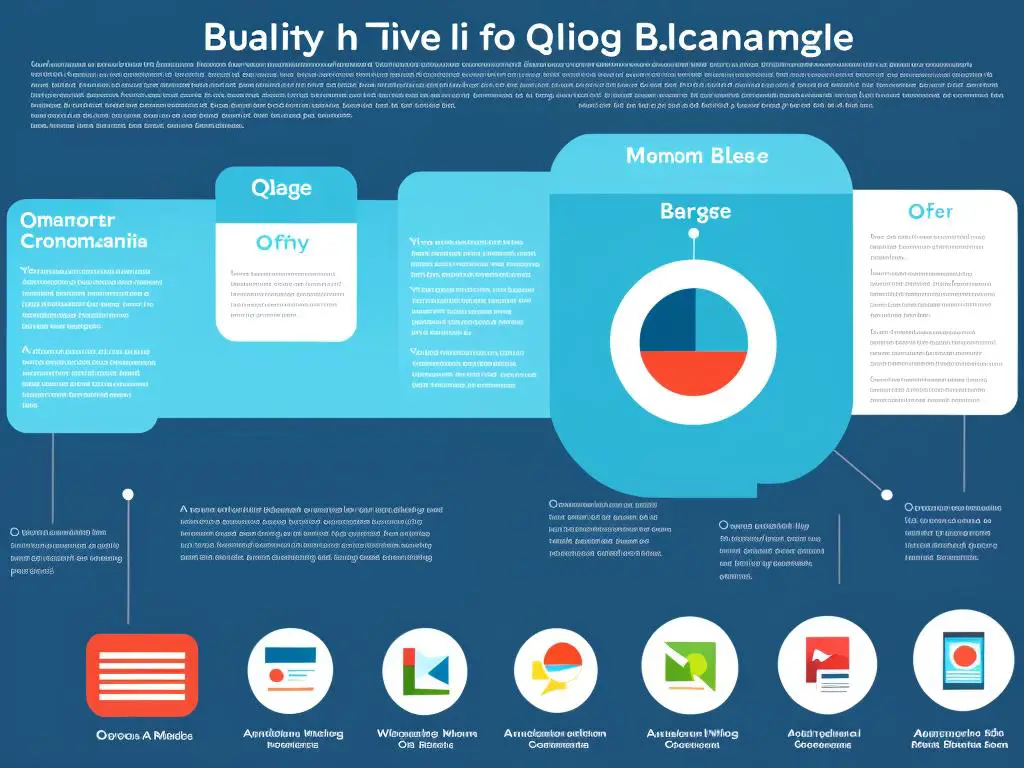With an increasing focus on generating online content for businesses, individuals, and organizations alike, the question of ‘quality versus quantity’ often arises. Regardless of your profession, if your task involves creating content, the one question that probably baffles you the most is whether to focus on producing one large quality blog post, or multiple shorter posts? How does each strategy impact your goals, and which would your audience appreciate more? Well, the answer might not be as straightforward as it seems. Through our detailed analysis of the pros and cons of each approach—based on factors such as engagement, SEO, time investment, reach and consistency—we aim to provide a comprehensive guide to help you make a wise decision, tailored to your specific needs and objectives.
Defining Quality and Quantity in Blog Posts
Defining Quality and Quantity in Blog Posts
It’s essential to understand what constitutes a quality blog post and what a quantity or multiple posts mean. A quality blog post is generally long-form content characterized by well-researched and in-depth information. These blogs usually tackle large, broad topics and provide comprehensive, insightful knowledge on the subject.
On the other hand, multiple posts or quantity blog posts refer to more frequent, short-form content. Each of these posts may cover different, smaller topics. These posts can be quicker to write and publish, and they provide a steady stream of new content for readers to enjoy.
Understanding the Impact of Quality and Quantity in Blogging
The quality versus quantity debate can have substantial impacts on various aspects of blogging, ranging from SEO (Search Engine Optimization) to reader engagement.
From an SEO perspective, search engines like Google value both the quality and the depth of content. Quality content tends to rank higher on search engine results pages, generating more traffic and visibility for your blog. One well-written, high-quality blog post could potentially attract a large audience and generate significant web traffic.
Conversely, the practice of publishing multiple posts can lead to more fresh content being presented to your audience, leading to regular site visits and opportunities for internal linking, both of which can also have positive SEO implications.
However, when it comes to reader engagement, there tends to be a preference for quality over quantity. Readers appreciate content-rich articles that offer valuable insights and unique perspectives. While frequent posting can keep your blog active and diverse, an oversaturation of content might overwhelm readers and deter them from fully engaging with your posts.
Making the Choice: Quality vs. Quantity in Blog Posts
- Understanding Your Audience: The decision between one quality post or multiple posts should first hinge on your audience’s appetite. Would they rather dig deep into a singular, comprehensive post? Or do they fancy regular, shorter updates?
- Resource Considerations: Quality typically requires more investment in terms of research, time, and energy. If resources are slim, multiple brief posts might be a better fit.
- Purpose of Your Blog: Should your blog serve as a reliable source for information on a specific topic, quality may be the best approach. However, for blogs focusing on consistent engagement with readers or regular updates on evolving subjects, quantity could take precedence.
In sum, the choice between a single substantial blog post and several smaller posts relies on your unique goals and circumstances. Striking a carefully measured balance, ensuring both consistent updates and a high level of quality, might just be the most effective solution.

Photo by andrewtneel on Unsplash
Advantages and Disadvantages of One Quality Post
The Positives of Prioritizing Quality
User Engagement: A single, meticulously crafted blog post can excel at increasing user engagement. Although it may require a larger time investment from readers, it often rewards by holding their attention longer and providing in-depth, thought-provoking content.
SEO Benefits: Search engines such as Google tend to favor longer, high-quality blog posts in the 1,000+ word range. The reasoning is simple – long-form posts have a higher chance of incorporating more keywords, making them more likely to align with user searches.
Trust-Building: A systematic, well-researched article can considerably enhance your credibility with readers. It signals expertise, drawing in those who place high value on depth and accuracy.
Disadvantages of One Quality Post
Time Investment: The time and effort required to produce a quality article can be considerable. From conducting extensive research to crafting skillful arguments to proofreading, the process could take days or even weeks.
Fewer Posts: Since creating a high-quality blog post often requires substantial time and resources, you might end up with fewer posts overall. This could potentially limit your website’s amount of fresh content and affect your SEO ranking.
Advantages of Multiple Posts
Increased Website Activity: Frequently updating your blog with new posts keeps your website active, improving its visibility on search engine results. Regular entries also provide readers with a reason to revisit your site.
Wide Topic Coverage: Creating multiple posts allows you to cover a broader range of topics, which helps expand your blog’s reach. You can target various audience segments and potentially attract more readers.
Disadvantages of Multiple Posts
Lower Quality: More isn’t always better. Producing posts in high volumes may compromise their quality. Poorly written or inadequately researched content could disappoint readers and harm your credibility.
Low SEO Rankings: Search engines view quality over quantity. Multiple low-quality posts can result in lower SEO rankings compared to one long, high-quality post. Also, shorter posts may not include as many keywords, which can negatively affect their visibility in search engine results.
When it comes to blogging, the age-old debate always seems to emerge – is it better to produce one high-quality post or multiple lower-quality posts? The answer is not as straightforward as it may initially seem, being heavily reliant on your specific goals, available resources, and the unique demands of your audience. Having said that, both strategies hold their respective benefits, and the optimal approach may well lie somewhere between the two extremes, requiring a delicate balance of quality and quantity.

Advantages and Disadvantages of Multiple Posts
Pros and Cons of Emphasizing Volume
In the realm of content marketing and Search Engine Optimization (SEO), the strategy of creating numerous blog posts has certainly made a name for itself, bringing with it an abundance of both merits and pitfalls. This could leave many content creators in a quandary, struggling to strike an optimal balance between the inevitable trade-off of quantity against quality.
Reach and Diversity
Making multiple blog posts can help you reach a wider audience and cover more topics. Every blog post you create represents a potential entry point for a new reader or an existing reader with a deep interest in a specific subtopic. Furthermore, a variety of posts on various topics indicates that you have a comprehensive understanding of your field, engendering trust in you as a source of authoritative information.
Consistency and Engagement
Consistent posting keeps your brand fresh in the minds of your readers. Regularity can breed familiarity, and readers may start looking forward to your regular posts. The consistency of multiple posts can foster reader engagement and community building, crucial for improving your site stickiness and time spent on your site.
SEO Implications
Publishing multiple posts increases your website’s exposure to search-engine indexing bots, potentially enhancing your website’s overall search-engine rankings. Each blog post presents a new opportunity to optimize for a specific keyword, allowing you to target more search phrases and generate more organic traffic.
Time-to-Value Ratio
However, the formula of simultaneous increase in quantity and quality can be elusive. Producing a lot of content quickly can compromise the value of each post. The time-to-value ratio might lean more heavily towards time, particularly if you don’t have a large content team or if you’re a solo blogger.
Considering Quality
Shifting focus towards a single, in-depth blog post over multiple posts deals with delivering high-quality content that imparts substantial knowledge, understanding, and thought leadership. A well-researched and intelligent post may captivate readers and command their attention more effectively than multiple superficial ones.
SEO Revelations
A single quality post still lends itself to SEO advantages. Long-form content has a tendency to rank higher in search engine results pages (SERPs). This is because it can delve deeply into associated subtopics, thus giving the search engine a broader context, enhancing its semantic relevance.
Time Commitment and Stand-Out Factor
Creating a single quality post can be comparatively time-consuming and resource-intensive. However, the investment can pay off since high-quality content can differentiate your blog from the multitude of quick, skim-read articles elsewhere on the web.
Summary
Ultimately, the decision between crafting a single quality blog post or numerous posts hinges on various factors such as your specific goals, available resources, the preferences of your target audience, and the subject matter at hand. Both strategies possess particular merits and can be integrated to create a potent content marketing plan. A balanced mixture of these methods could result in optimal viewer engagement and SEO outcomes, where frequent, concise posts foster sustained reader interest, and occasional detailed posts showcase your knowledge and leadership in your field.

Determining What Works Best for Your Goals
Assessing Your Objectives
Deciding whether to focus on producing one comprehensive blog post or several posts should largely be influenced by your individual goals. Are you aiming to enhance your online presence through superior search engine rankings? Or are you more interested in building authority in your field by presenting comprehensive, value-rich content?
If your primary objective is to elevate your website’s SEO, following a regular blogging regimen could prove more advantageous. Search engines like Google show preference to sites that consistently generate fresh, relevant content. Regularly updated content also promotes reader engagement, as it reaffirms your active participation on your blog or website.
On the other hand, creating one high-quality post necessitates considerable time and research. However, the reward can be substantial. Presenting a well-researched, authoritative blog post can establish you as a recognized expert in your industry and draw a steady flow of visitors over a period of time. Furthermore, it could enhance your chances of acquiring backlinks, leading to a substantial rise in your SEO rankings.
Understanding Your Audience
Another crucial factor to consider is the type of audience you’re trying to reach. Some audiences prefer frequent, short, and light posts, while others prefer in-depth content that comes less often but provides significant value. Ideally, your content schedule should align with your audience’s preferences to maximize reader engagement. Conducting audience research and evaluating your blog’s engagement metrics can provide valuable insights into your readers’ content preferences.
Content Topic Considerations
The nature of your content topic can also influence whether a quality-over-quantity or a quantity-over-quality strategy is best. Some topics require detailed exploration and extensive research to provide real value to readers, making a single, high-quality post the better choice. Meanwhile, other topics may be easier to break up and present in several smaller, frequent posts, allowing for faster dissemination and easier consumption of information.
A Balanced Approach to Blogging Strategy
Essentially, the choice between one quality blog post and multiple posts isn’t strictly a binary one. Both quality and quantity have their roles to play in successful blogging strategy. It is more about striking a balance that works best for your unique context and requirements. It might be beneficial to have a blend of both strategies – regular blog posts to maintain search engine ranking and audience engagement, interspersed with high-quality, longer blog posts to establish industry authority.
Remember, the key to a successful blog is producing content that aligns with both your goals and your audience’s needs. So, be flexible and willing to adjust your content strategy as these factors evolve over time.

Engaging your readers through thoughtful, informative content is not a one-size-fits-all approach. Choosing to maintain a steady stream of shorter posts versus dedicating resources to produce fewer, in-depth pieces is a strategic decision that hinges on many factors. Your audience’s preferences, the nature of your blog’s topic, the SEO implications, and your ultimate goals must all be taken into account. Therefore, while recognizing the merits of both quality and quantity in the blogosphere, we encourage you to use this guide as a starting point to determine and shape your unique blogging strategy. In doing so, remember that the real victory lies in delivering value to your audience, regardless of whether it’s through a single, comprehensive post or multiple brief ones.

